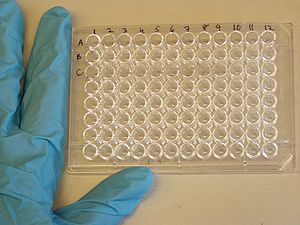
In vitro toxicology
Encyclopedia
In vitro toxicity testing
is the scientific analysis
of the effects of toxic chemical substance
s on cultured bacteria
or mammalian cells
. In vitro (literally 'in glass') testing methods are employed primarily to identify potentially hazardous chemicals and/or to confirm the lack of certain toxic properties in the early stages of the development of potentially useful new substances such as therapeutic drugs
, agricultural chemicals and food additives.
In vitro assays for xenobiotic toxicity are recently carefully considered by key government agencies (e.g. EPA; NIEHS/NTP; FDA), to better assess human risks. There are substantial activities in using in vitro systems to advance mechanistic understanding of toxicant activities, and the use of human cells and tissue to define human-specific toxic effects.
Due to regulatory constraints and ethical considerations, the quest for alternatives to animal testing has gained a new momentum. In many cases the in vitro tests are better than animal tests because they can be used to develop safer products.

Measurement of these types of cellular responses can be windows into the interaction of the test article on the test models (monolayer cell cultures, 3D tissue models, tissue explants).
Toxicology testing
Toxicology testing, also known as safety testing, or toxicity testing, is conducted by pharmaceutical companies testing drugs, or by contract animal testing facilities such as Huntingdon Life Sciences and Inveresk Research International on behalf of a wide variety of customers, including the...
is the scientific analysis
Scientific method
Scientific method refers to a body of techniques for investigating phenomena, acquiring new knowledge, or correcting and integrating previous knowledge. To be termed scientific, a method of inquiry must be based on gathering empirical and measurable evidence subject to specific principles of...
of the effects of toxic chemical substance
Chemical substance
In chemistry, a chemical substance is a form of matter that has constant chemical composition and characteristic properties. It cannot be separated into components by physical separation methods, i.e. without breaking chemical bonds. They can be solids, liquids or gases.Chemical substances are...
s on cultured bacteria
Bacteria
Bacteria are a large domain of prokaryotic microorganisms. Typically a few micrometres in length, bacteria have a wide range of shapes, ranging from spheres to rods and spirals...
or mammalian cells
Cell (biology)
The cell is the basic structural and functional unit of all known living organisms. It is the smallest unit of life that is classified as a living thing, and is often called the building block of life. The Alberts text discusses how the "cellular building blocks" move to shape developing embryos....
. In vitro (literally 'in glass') testing methods are employed primarily to identify potentially hazardous chemicals and/or to confirm the lack of certain toxic properties in the early stages of the development of potentially useful new substances such as therapeutic drugs
Medication
A pharmaceutical drug, also referred to as medicine, medication or medicament, can be loosely defined as any chemical substance intended for use in the medical diagnosis, cure, treatment, or prevention of disease.- Classification :...
, agricultural chemicals and food additives.
In vitro assays for xenobiotic toxicity are recently carefully considered by key government agencies (e.g. EPA; NIEHS/NTP; FDA), to better assess human risks. There are substantial activities in using in vitro systems to advance mechanistic understanding of toxicant activities, and the use of human cells and tissue to define human-specific toxic effects.
Improvement over animal testing
Most toxicologists believe that in vitro toxicity testing methods can be more useful, more time and cost-effective to toxicology studies in living animals (which are termed in vivo or "in life" methods).Due to regulatory constraints and ethical considerations, the quest for alternatives to animal testing has gained a new momentum. In many cases the in vitro tests are better than animal tests because they can be used to develop safer products.

Example cell viability (cytotoxicity) assays used for In-vitro toxicology
Many methods of analysis exist for assaying test substances for cytotoxicity and other cellular responses.MTT
MTT assay is used often in determining cell viability and has been validated for use by international organisations. MTT assay involves two steps of introducing the assay to the chemicals and then a solubilisation stepMTS
The colourimetric MTS (3-(4,5-dimethylthiazol-2-yl)-5-(3-carboxymethoxyphenyl)-2-(4-sulfophenyl)-2Htetrazolium) in vitro assay is an updated version of the validated MTT method, MTS assay has the advantage of being soluble and hence no solubilisation step is required.ATP
ATP assay has the main advantage of providing results quickly (within 15 minutes) and only requires fewer sample cells. The assay performs lysis on the cells and the following chemical reaction between the assay and ATP content of cells produces luminescence. The amount of luminescence is then measured by a photometer and can be translated into number cells alive since- ATP assay assumes alive cells still have ATP inside it.
- Luminescence level recorded is proportional to the ATP content in the sample cells
Neutral Red
Another cell viability endpoint can be Neutral Red uptake. Neutral Red(NR), a weak cationic dye penetrates cellular membranes by non-diffusion and accumulates intercelluarly in lysosomes. Viable cells take up the NR dye, damaged or dead cells do not.Enzyme-linked immunosorbent assay (ELISA)
ELISA kits can be used to examine up and down regulation of proinflammatory mediators such as cytokines (IL-1, TNF alpha, PGE2)....Measurement of these types of cellular responses can be windows into the interaction of the test article on the test models (monolayer cell cultures, 3D tissue models, tissue explants).
External links
- Mouse Lymphoma Assay Calculations
- Introduction to Genetic Toxicology
- Alt Web
- The Johns Hopkins Center for Alternatives to Animal Testing (CAAT)
- 3-D, Human Cell-Derived TISSUES for Tox. Testing - MatTek Corp.
- In Vitro and Alternative Methods Specialty Section
- In Vitro Phototoxicity Testing
- Integrated_Discrete_Multiple_Organ_CoCulture_Assays for toxicity
- Informational source on types of in vitro assays

